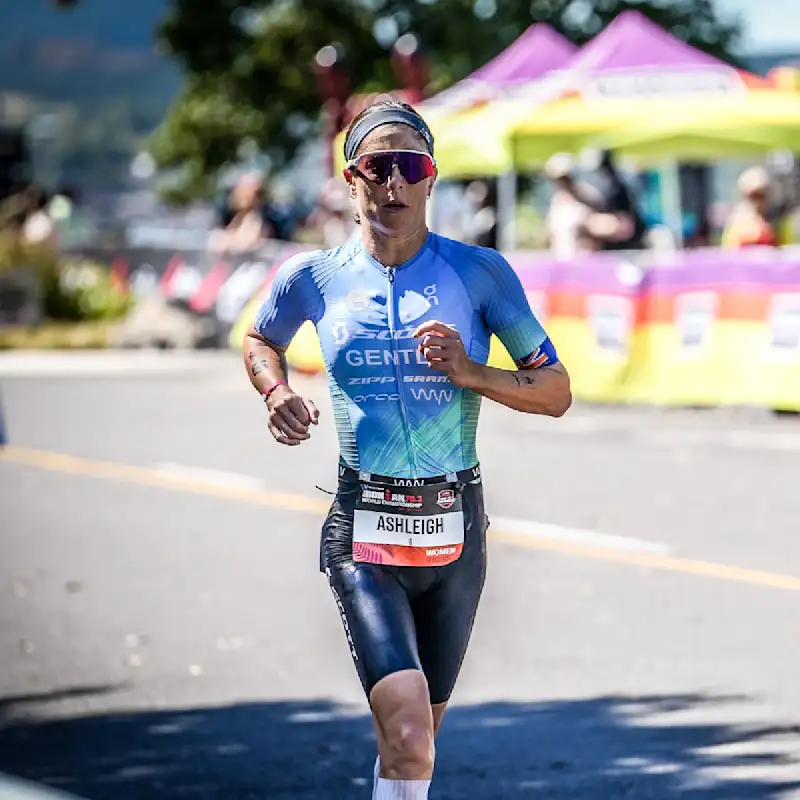
Ashleigh Gentle
PTO Canadian Open
Ashleigh's headline numbers
Ashleigh's strategy
Fueling
Carbohydrate is the main fuel you burn when racing. Failing to fuel properly is a leading cause of underperformance in longer races.
Ash followed the scientific guidelines by having a carb-rich breakfast to top up her liver glycogen stores on race morning. In the final 15 minutes before the start, she had a PF 30 Caffeine Gel to raise her blood glucose levels and provide quick-release energy for the swim, offering a glycogen-sparing effect. Once on the bike, Ash consumed her highest intake to date of ~102g of carb per hour. She used a bottle filled with PF 30 Gels and some water, to set herself up to deliver the fastest run of the day. Over the course of this season, Ash has been working with our Sport Science team to increase her carb intake through strategic gut training. This has allowed her to progress her average intake from ~50g/h at Clash Miami in March to ~84g/h at the PTO Canadian Open which provides a significant benefit to her energy levels and performance.
Hydration
Taking on board an appropriate amount of fluid and sodium is essential to maintaining blood volume and supporting the cardiovascular effort needed to perform on race day.
Whilst the absolute amount of sodium and fluid consumed per hour is important, it’s critical to consider these in relation to each other. This is known as 'relative sodium concentration' and it’s expressed in milligrams per litre (mg/L). How much sodium you’re taking in per litre of fluid is more important than the absolute amount taken in per hour.
Sweat sodium concentration (mg/L) is largely genetically determined and remains relatively stable. Knowing how salty your sweat is enables you to replace a good proportion of your sweat losses, which can range from 200-2,000mg/L.
Whilst Ashleigh’s losses are on the moderate side, getting her hydration strategy right is still crucial when it’s hot and/or humid as her higher sweat rate in these conditions can result in significant net losses over the duration of a race.
Learn moreWith hot and humid conditions expected, Ash preloaded with PH 1500 (Drink Mix) 90 minutes before the race to optimise water retention and start well hydrated. To maintain her fluid and electrolyte balance during the race, Ash used PH 1000 (Drink Mix) on the bike. However, drinking plain water on the run diluted her relative sodium concentration below what we would recommend to adequately replace her losses. Ash has a low sweat rate and has shown through previous successes in hot races that she doesn’t require as much fluid as other athletes. She can get away with less than what we would usually advise in warm conditions, so her intake here was actually appropriate for her needs to keep any dehydration symptoms at bay and maintain her performance.
Caffeine
Beyond the Three Levers of Performance (carb, sodium and fluid), caffeine is one of only a few substances that is proven to improve performance for most endurance athletes as it can help stave off mental and physical fatigue.
Ash used a PF 30 Caffeine Gel before the start and another one on the bike to maintain a level of caffeine within the recommended range of 3-6mg/kg. This strategy would have reduced her perception of fatigue enabling her to maintain a high power output throughout the race and achieve this excellent result.
How Ashleigh hit her numbers
Here's everything that Ashleigh ate and drank on the day...
Ashleigh's weapons of choice
Final thoughts
Ashleigh's full stats
Data Confidence?
There is good confidence in the accuracy of the data reported. An athlete feels that the numbers closely reflect what they consumed despite a couple of estimations which may carry some degree of error. The majority of what was consumed is recorded to a high level of specificity (most volumes are known through the use of bottles brands quantities flavours). The numbers are very plausible and align with previous data recordings (if an athlete has collected data previously).